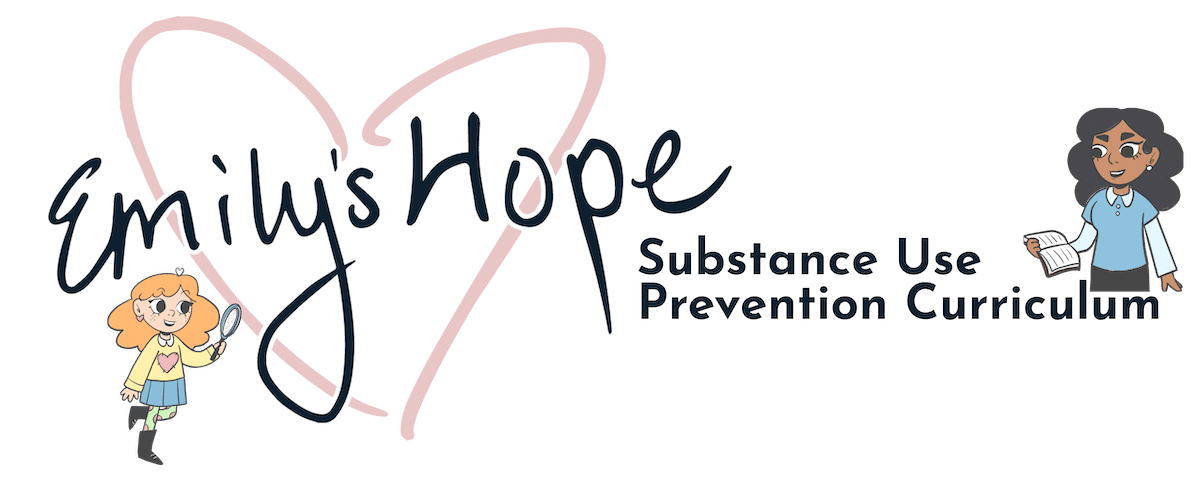Your child’s school has partnered with Emily’s Hope to implement the Emily’s Hope Substance Use Prevention Curriculum. This curriculum seeks to support educators with age-appropriate substance and substance use lessons from Kindergarten through Middle and High School years. The educational series aims to educate children through teens on the effects of substances on the brain, body, and life to promote healthy choices. Individual lessons address the science, social, and health aspects of substance use, as well as dealing with the complex emotions and wellness of the entire family.
Emily’s Hope Substance Use Prevention Curriculum developers integrate animated characters throughout the curriculum. The animated characters allow for a more straightforward implementation of difficult topics. Students should relate to the characters, making the connections to their behaviors and struggles more relevant.
Emily’s Hope Prevention materials align with standards from the National Consensus for School Health Education and ASCA (American School Counselor Association) Mindsets & Behaviors. Further, Vivek Anand, MD, worked closely with the committee, and his experience working with children and addiction medicine was relied on heavily throughout the process. We encourage you to read the letter of support from Dr. Anand. His knowledge and experience leave little doubt about this curriculum’s impact on our children.
Finally, we encourage you to have open conversations with your student about what is being discussed in these lessons and also want you to know that your school is here as a resource for you should difficult questions arise.

A letter from
Dr. Vivek Anand
- Attending Physician, Avera Behavioral Health Hospital
- Attending Physician, Avera Addiction Care Center
- Associate Professor, Department of Psychiatry, Sanford School of Medicine, University of South Dakota
As a child psychiatrist and a specialist in addiction medicine, my day includes caring for many patients, including children, teenagers, and adults struggling with substance use disorders and related consequences. Substance use disorders are so prevalent that they frequently impact many individuals and their families silently or explicitly. Established substance use disorder during adulthood usually has its foundation during an individual’s developmental years. Childhood and teenage years, instrumental for normal development, are also characterized by the emergence of pathological behaviors, including drug experimentation and eventual progression to substance use disorders. The brain appears to undergo remarkable developmental phases until the mid-20s, characterized by many social, emotional, cognitive, and behavioral changes. Although characterized by extraordinary changes in the brain, this period also tends to be the most vulnerable time, putting young individuals at high risk of initiating substances.
Historically, substance use prevention efforts have focused on reducing the supply or using scare tactics which have not been shown to help. However, reducing demand by increasing educational efforts seems a critical but often missed component of substance use prevention. The available research indicates that earlier initiation of substance use, during childhood or adolescence, is more likely to progress to established use and development of substance use disorders. Therefore, it makes perfect sense to delay the use of substances as much as possible. The traditional prevention programs have focused on middle and high school students with some success. However, age-appropriate educational programs focusing on elementary school students help educate, change attitudes and perceptions due to ever-changing popular culture, and inform future decision-making when available substances are lacking. Evidence shows that substance use prevention strategies are likely to be more promising if they enhance drug-refusing skills informed by age-appropriate social and emotional development, early engagement in problem-solving and solution-focused approaches, and the refusal of high-risk behaviors. In essence, school-based programs focusing on children from early development through elementary and middle school are needed to achieve long-term preventative goals and a real public health impact. It appears that structured in-school substance use prevention in kindergarten may be the best practice that may need to be bolstered during the first-third grades. The knowledge base acquired from kindergarten through third grade is likely to help children make better decisions when they are peer-influenced during late elementary and later school years to refrain from experimenting with substances. Implementing such comprehensive multi-grade reinforced programs in early school years is simply going to help improve drug use outcomes during middle school, high school, and later in life, resulting in a reduced impact of substance use, particularly the opioid epidemic, in the near future.
The schools have made efforts with education, but they seem to be somewhat delayed due to multiple barriers, including the fast-paced substance use epidemic, school resource constraints, teacher time- limitations, and our cultural dilemma about addressing drugs during childhood. This book and curriculum was designed to assist teachers, health educators, and school policymakers in your school district. This book has been created by a team of motivated educators, teachers, scientists, and physicians in your community to provide age-appropriate education from kindergarten through fifth-grade level. This curriculum will help with social development, emotional skill building, and knowledge to help our students exercise control, develop resilience and resistance, and make informed decisions to help them stay free from substances throughout their schooling and later years. An extensive attempt has been made to keep the book/curriculum lessons concise, clear, and age-appropriate. This book/curriculum hopes to achieve its objectives by teaching elementary school children about their body, body parts, brain function, neurotransmitters, substance use, and the effects of using substances on the brain and body. I believe this time investment during elementary years to reduce substance use will help these students experience a better quality of life and community citizenship.
Sincerely,
Vivek Anand, MD
Attending Physician, Avera Behavioral Health Hospital
Attending Physician, Avera Addiction Care Center
Associate Professor, Department of Psychiatry, Sanford School of Medicine, University of South Dakota
